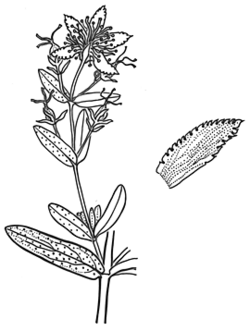Synonyms: Ascyrum APNI*

Description: Glabrous herbs or shrubs.
Leaves opposite, gland-dotted, sessile.
Inflorescences mostly terminal, variable. Flowers bisexual, yellow to orange [or rarely white]. Sepals and petals usually 5, sometimes gland-dotted. Stamens usually basally united in 3–5 bundles; anthers with a small apical gland. Ovary mostly 3–5-locular, or partly or completely 1-locular, with 3–5 parietal intruding placentas bearing numerous ovules.
Fruit a 3–5-valved septicidal capsule or berry; seeds many, minute.
Distribution and occurrence: World: c. 490 spp,, mainly temperate regions. Australia: c. 18 spp. (c. 16 naturalised, including 1 hybrid), all States.
Many European and Asian species are cultivated as ornamentals; some have become garden escapes and environmental weeds. Many species have chemical medicinal properties and have been used in traditional folk medicine; some contain toxins that can cause poisoning in livestock. There is variability in the native plants currently identified as Hypericum gramineum and H. japonicum in Australia, and in light of preliminary morphological and molecular investigations there is the possibility of new taxa, the misapplication of names, hybridisation of taxa, etc. Reference: Robson, N.K.B. (2016). And then came molecular phylogenetics - reactions to a monographic study of Hypericum (Hypericaceae). Phytotaxa 255: 181-198. Further information on the genus can be found at "Hypericum online" at http://hypericum.myspecies.info/
Text by C. Miller, Flora of NSW Vol. 1 (1990); edited K.L. Wilson (February 2007); P.G. Kodela (April 2017)
Taxon concept: Australian Plant Census (accessed April 2017)
| | Key to the species | |
| 1 | Largest leaves no more than 35 mm long; herbs, rarely subshrubs or shrubs (H. hypericoides a shrub, but leaves less than 35 mm long) | 2 |
| Largest leaves usually 40 mm long or more; shrubs or subshrubs, rarely herbs | 6 |
| 2 | Plants without black gland-dots | 3 |
| Black gland-dots present on petals and either black or orange gland on anthers (black gland-dots often also on leaves, stems, and/or sepals)
Back to 1 | 5 |
| 3 | Semi-aquatic; emergent parts variously crisped-pubescent to tomentose; leaf lamina broadly ovate to ± circular | Hypericum elodes |
| Terrestrial; ± glabrous (aside from glands); leaf lamina ovate to obovate
Back to 2 | 4 |
| 4 | Stems erect; leaves ovate to narrowly elliptic, at least the uppermost stem-clasping, margin usually recurved; flowers in leafy cymes; pedicels generally longer than subtending leaves; mature capsule usually exceeding sepals | Hypericum gramineum |
| Stems prostrate or procumbent; leaves elliptic to obovate, spreading from stems, margin not recurved (but often undulate); flowers often solitary; pedicels shorter than subtending leaves; mature capsule no longer than sepals
Back to 3 | Hypericum japonicum |
| 5 | Sepals with black gland-dots; stems procumbent, decumbent or erect | Hypericum hypericoides |
| Sepals without black gland-dots; stems erect or ascending
Back to 2 | Hypericum perforatum |
| 6 | Flowers solitary, terminal; styles 5 | Hypericum calycinum |
| Flowers in terminal cymes; styles 3 or 5
Back to 1 | 7 |
| 7 | Shrub to 4 m high; lacking black glands; leaves narrowly elliptic to somewhat oblong or narrowly ovate, attenuate or cuneate at base, apex usually acute; petals persistent NOT IN NSW | Hypericum canariense |
| Shrub to 1.5 m, rarely to 2 m high; often with black glands (absent in H. kouytchense); leaves oblong to broadly elliptic or ovate, rounded or cordate at base (cuneate in H. patulum), apex usually obtuse (sometimes acute in H. kouytchense); petals soon caducous
Back to 6 | 8 |
| 8 | Petals shorter than to slightly longer than sepals; ripe fruit purple to black; leaves strongly discolorous, more or less curry-scented | Hypericum androsaemum |
| Petals at least twice as long as sepals; ripe fruit reddish; leaves ± concolorous to somewhat discolourous, minutely reticulate-patterned beneath, curry-scented or not
Back to 7 | 9 |
| 9 | Flowers 40–65 mm diam.; sepal margin entire (or sometimes with a few cilia near apex) | Hypericum kouytchense |
| Flowers 25–40 mm diam.; sepal margin apically denticulate-ciliolate
Back to 8 | Hypericum patulum |
|


